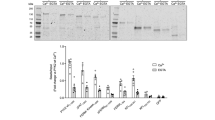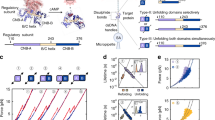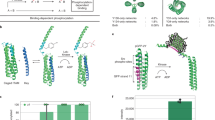Abstract
Proline switches, controlled by cis-trans isomerization, have emerged as a particularly effective regulatory mechanism in a wide range of biological processes. Here we report the structures of both the cis and trans conformers of a proline switch in the Crk signaling protein. Proline isomerization toggles Crk between two conformations: an autoinhibitory conformation, stabilized by the intramolecular association of two tandem SH3 domains in the cis form, and an uninhibited, activated conformation promoted by the trans form. In addition to acting as a structural switch, the heterogeneous proline recruits cyclophilin A, which accelerates the interconversion rate between the isomers, thereby regulating the kinetics of Crk activation. The data provide atomic insight into the mechanisms that underpin the functionality of this binary switch and elucidate its remarkable efficiency. The results also reveal new SH3 binding surfaces, highlighting the binding versatility and expanding the noncanonical ligand repertoire of this important signaling domain.
This is a preview of subscription content, access via your institution
Access options
Subscribe to this journal
Receive 12 print issues and online access
$259.00 per year
only $21.58 per issue
Buy this article
- Purchase on Springer Link
- Instant access to full article PDF
Prices may be subject to local taxes which are calculated during checkout







Similar content being viewed by others
References
Birge, R.B., Kalodimos, C., Inagaki, F. & Tanaka, S. Crk and CrkL adaptor proteins: networks for physiological and pathological signaling. Cell Commun. Signal. 7, 13 (2009).
Feller, S.M. Crk family adaptors-signalling complex formation and biological roles. Oncogene 20, 6348–6371 (2001).
Miller, C.T. et al. Increased C–CRK proto-oncogene expression is associated with an aggressive phenotype in lung adenocarcinomas. Oncogene 22, 7950–7957 (2003).
Nishihara, H. et al. Molecular and immunohistochemical analysis of signaling adaptor protein Crk in human cancers. Cancer Lett. 180, 55–61 (2002).
Linghu, H. et al. Involvement of adaptor protein Crk in malignant feature of human ovarian cancer cell line MCAS. Oncogene 25, 3547–3556 (2006).
Shishido, T. et al. Crk family adaptor proteins trans-activate c-Abl kinase. Genes Cells 6, 431–440 (2001).
Sirvent, A., Benistant, C. & Roche, S. Cytoplasmic signalling by the c-Abl tyrosine kinase in normal and cancer cells. Biol. Cell 100, 617–631 (2008).
Feller, S.M., Knudsen, B. & Hanafusa, H. c-Abl kinase regulates the protein binding activity of c-Crk. EMBO J. 13, 2341–2351 (1994).
Songyang, Z. et al. SH2 domains recognize specific phosphopeptide sequences. Cell 72, 767–778 (1993).
Wu, X. et al. Structural basis for the specific interaction of lysine-containing proline-rich peptides with the N-terminal SH3 domain of c-Crk. Structure 3, 215–226 (1995).
Sarkar, P., Reichman, C., Saleh, T., Birge, R.B. & Kalodimos, C.G. Proline cis-trans isomerization controls autoinhibition of a signaling protein. Mol. Cell 25, 413–426 (2007).
Kobashigawa, Y. et al. Structural basis for the transforming activity of human cancer-related signaling adaptor protein CRK. Nat. Struct. Mol. Biol. 14, 503–510 (2007).
Reichman, C. et al. Transactivation of Abl by the Crk II adapter protein requires a PNAY sequence in the Crk C-terminal SH3 domain. Oncogene 24, 8187–8199 (2005).
Akakura, S. et al. C-terminal SH3 domain of CrkII regulates the assembly and function of the DOCK180/ELMO Rac-GEF. J. Cell. Physiol. 204, 344–351 (2005).
Kizaka-Kondoh, S., Matsuda, M. & Okayama, H. CrkII signals from epidermal growth factor receptor to Ras. Proc. Natl. Acad. Sci. USA 93, 12177–12182 (1996).
Ogawa, S. et al. The C-terminal SH3 domain of the mouse c-Crk protein negatively regulates tyrosine-phosphorylation of Crk associated p130 in rat 3Y1 cells. Oncogene 9, 1669–1678 (1994).
Nicholson, L.K. & Lu, K.P. Prolyl cis-trans Isomerization as a molecular timer in Crk signaling. Mol. Cell 25, 483–485 (2007).
Isakov, N. A new twist to adaptor proteins contributes to regulation of lymphocyte cell signaling. Trends Immunol. 29, 388–396 (2008).
Lu, K.P., Finn, G., Lee, T.H. & Nicholson, L.K. Prolyl cis-trans isomerization as a molecular timer. Nat. Chem. Biol. 3, 619–629 (2007).
Andreotti, A.H. Native state proline isomerization: an intrinsic molecular switch. Biochemistry 42, 9515–9524 (2003).
Göthel, S.F. & Marahiel, M.A. Peptidyl-prolyl cis-trans isomerases, a superfamily of ubiquitous folding catalysts. Cell. Mol. Life Sci. 55, 423–436 (1999).
Brazin, K.N., Mallis, R.J., Fulton, D.B. & Andreotti, A.H. Regulation of the tyrosine kinase Itk by the peptidyl-prolyl isomerase cyclophilin A. Proc. Natl. Acad. Sci. USA 99, 1899–1904 (2002).
Wulf, G., Finn, G., Suizu, F. & Lu, K.P. Phosphorylation-specific prolyl isomerization: is there an underlying theme? Nat. Cell Biol. 7, 435–441 (2005).
Pastorino, L. et al. The prolyl isomerase Pin1 regulates amyloid precursor protein processing and amyloid-beta production. Nature 440, 528–534 (2006).
Calabrese, M.F., Eakin, C.M., Wang, J.M. & Miranker, A.D. A regulatable switch mediates self-association in an immunoglobulin fold. Nat. Struct. Mol. Biol. 15, 965–971 (2008).
Lummis, S.C. et al. Cis-trans isomerization at a proline opens the pore of a neurotransmitter-gated ion channel. Nature 438, 248–252 (2005).
Nelson, C.J., Santos-Rosa, H. & Kouzarides, T. Proline isomerization of histone h3 regulates lysine methylation and gene expression. Cell 126, 905–916 (2006).
Wang, Z. et al. Pro isomerization in MLL1 PHD3-bromo cassette connects H3K4me readout to CyP33 and HDAC-mediated repression. Cell 141, 1183–1194 (2010).
Eckert, B., Martin, A., Balbach, J. & Schmid, F.X. Prolyl isomerization as a molecular timer in phage infection. Nat. Struct. Mol. Biol. 12, 619–623 (2005).
Franke, E.K., Yuan, H.E. & Luban, J. Specific incorporation of cyclophilin A into HIV-1 virions. Nature 372, 359–362 (1994).
OuYang, B., Pochapsky, S.S., Dang, M. & Pochapsky, T.C. A functional proline switch in cytochrome P450cam. Structure 16, 916–923 (2008).
Vogel, M., Bukau, B. & Mayer, M.P. Allosteric regulation of Hsp70 chaperones by a proline switch. Mol. Cell 21, 359–367 (2006).
Severin, A., Joseph, R.E., Boyken, S., Fulton, D.B. & Andreotti, A.H. Proline isomerization preorganizes the Itk SH2 domain for binding to the Itk SH3 domain. J. Mol. Biol. 387, 726–743 (2009).
Muralidharan, V. et al. Solution Structure and folding characteristics of the C-terminal SH3 domain of c-Crk-II. Biochemistry 45, 8874–8884 (2006).
Palmer, A.G. III. NMR characterization of the dynamics of biomacromolecules. Chem. Rev. 104, 3623–3640 (2004).
Mittermaier, A. & Kay, L.E. New tools provide new insights in NMR studies of protein dynamics. Science 312, 224–228 (2006).
Knudsen, B.S. et al. Affinity and specificity requirements for the first Src homology 3 domain of the Crk proteins. EMBO J. 14, 2191–2198 (1995).
Ren, R., Ye, Z.S. & Baltimore, D. Abl protein-tyrosine kinase selects the Crk adapter as a substrate using SH3-binding sites. Genes Dev. 8, 783–795 (1994).
Mallis, R.J., Brazin, K.N., Fulton, D.B. & Andreotti, A.H. Structural characterization of a proline-driven conformational switch within the Itk SH2 domain. Nat. Struct. Biol. 9, 900–905 (2002).
Rosen, M.K. et al. Direct demonstration of an intramolecular SH2-phosphotyrosine interaction in the Crk protein. Nature 374, 477–479 (1995).
Donaldson, L.W., Gish, G., Pawson, T., Kay, L.E. & Forman-Kay, J.D. Structure of a regulatory complex involving the Abl SH3 domain, the Crk SH2 domain, and a Crk-derived phosphopeptide. Proc. Natl. Acad. Sci. USA 99, 14053–14058 (2002).
Mayer, B.J., Hamaguchi, M. & Hanafusa, H. A novel viral oncogene with structural similarity to phospholipase C. Nature 332, 272–275 (1988).
Zvara, A. et al. Activation of the focal adhesion kinase signaling pathway by structural alterations in the carboxyl-terminal region of c-Crk II. Oncogene 20, 951–961 (2001).
Li, S.S. Specificity and versatility of SH3 and other proline-recognition domains: structural basis and implications for cellular signal transduction. Biochem. J. 390, 641–653 (2005).
Vaynberg, J. et al. Structure of an ultraweak protein-protein complex and its crucial role in regulation of cell morphology and motility. Mol. Cell 17, 513–523 (2005).
Bax, A. & Grishaev, A. Weak alignment NMR: a hawk-eyed view of biomolecular structure. Curr. Opin. Struct. Biol. 15, 563–570 (2005).
Popovych, N., Tzeng, S.R., Tonelli, M., Ebright, R.H. & Kalodimos, C.G. Structural basis for cAMP-mediated allosteric control of the catabolite activator protein. Proc. Natl. Acad. Sci. USA 106, 6927–6932 (2009).
Schwieters, C.D., Kuszewski, J.J. & Clore, M.G. Using Xplor–NIH for NMR molecular structure determination. Prog. Nucl. Magn. Reson. Spectrosc. 48, 47–62 (2006).
Cornilescu, G., Delaglio, F. & Bax, A. Protein backbone angle restraints from searching a database for chemical shift and sequence homology. J. Biomol. NMR 13, 289–302 (1999).
Tzeng, S.R. & Kalodimos, C.G. Dynamic activation of an allosteric regulatory protein. Nature 462, 368–372 (2009).
Acknowledgements
This work was supported by the US National Institutes of Health (GM80308 to C.G.K.).
Author information
Authors and Affiliations
Contributions
C.G.K. designed the research; P.S., T.S. and S.-R.T. performed the research; P.S., T.S., S.-R.T. and C.G.K. analyzed data; R.B.B. contributed reagents; and C.G.K. wrote the manuscript.
Corresponding author
Ethics declarations
Competing interests
The authors declare no competing financial interests.
Supplementary information
Supplementary Text and Figures
Supplementary Methods, Supplementary Figures 1–12 and Supplementary Table 1 (PDF 6967 kb)
Supplementary Movie
Crk cis-trans isomerization (MOV 1900 kb)
Rights and permissions
About this article
Cite this article
Sarkar, P., Saleh, T., Tzeng, SR. et al. Structural basis for regulation of the Crk signaling protein by a proline switch. Nat Chem Biol 7, 51–57 (2011). https://doi.org/10.1038/nchembio.494
Received:
Accepted:
Published:
Issue Date:
DOI: https://doi.org/10.1038/nchembio.494
This article is cited by
-
Cis-trans isomerization of peptoid residues in the collagen triple-helix
Nature Communications (2023)
-
Atomic view of the energy landscape in the allosteric regulation of Abl kinase
Nature Structural & Molecular Biology (2017)
-
Initiation of prolyl cis-trans isomerisation in the CDR-H3 loop of an antibody in response to antigen binding
Scientific Reports (2017)
-
Cyclophilin A promotes cell migration via the Abl-Crk signaling pathway
Nature Chemical Biology (2016)
-
Iterative tyrosine phosphorylation controls non-canonical domain utilization in Crk
Oncogene (2015)



